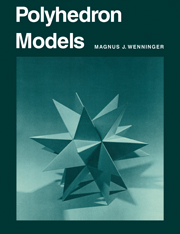Book contents
- Frontmatter
- Dedication
- Contents
- Preface to 1978 reprint
- Preface
- Foreword
- Introduction: uniform polyhedra
- Mathematical classification
- Section I The Convex Uniform Polyhedra: The Platonic and Archimedean Solids
- Section II Some Stellations and Compounds
- Section III Non-convex Uniform Polyhedra
- Commentary
- General instructions for making models of non-convex polyhedra
- Non-convex polyhedra (67–109)
- Commentary on non-convex snub polyhedra
- Non-convex snub polyhedra (110–119)
- A final comment
- Epilogue
- References
- List of models
General instructions for making models of non-convex polyhedra
from Section III - Non-convex Uniform Polyhedra
Published online by Cambridge University Press: 05 August 2015
- Frontmatter
- Dedication
- Contents
- Preface to 1978 reprint
- Preface
- Foreword
- Introduction: uniform polyhedra
- Mathematical classification
- Section I The Convex Uniform Polyhedra: The Platonic and Archimedean Solids
- Section II Some Stellations and Compounds
- Section III Non-convex Uniform Polyhedra
- Commentary
- General instructions for making models of non-convex polyhedra
- Non-convex polyhedra (67–109)
- Commentary on non-convex snub polyhedra
- Non-convex snub polyhedra (110–119)
- A final comment
- Epilogue
- References
- List of models
Summary
The non-convex uniform polyhedra are described, each showing the facial planes required and the pattern of parts arising from the intersection of the facial planes. No specific dimensions or measurements are given for any of these drawings because there is a very simple relationship which will give you the key to all of them. It lies in the fact that the pentagram or fivepointed star and the decagram or ten-pointed star both exhibit the golden ratio in their dimensions. Thus whenever these stars are found along with other regular polygons these polygons have their edges divided according to the golden ratio τ = 1.618 approximately. This is illustrated by way of the examples on p.99. The octagram or eight-pointed star exhibits the famous √2 in its metrical properties, √2 = 1.414 approximately. Thus once you have drawn these three stars accurately you have all the measurements in the line segments of the stars themselves. It is only in the more intricate models that some further points on the edges will be needed, but again you will find that the golden ratio turns up once more in these smaller segments. Thus a careful study of the drawings will enable you to make the models of any desired size.
The facial planes of the non-convex uniform polyhedra are not always entirely visible. Sometimes some portion of the plane is hidden in the interior of the solid, or a portion is visible as the upper part of the surface while another is visible as the lower or reverse side of the same surface. The light shading is used to show the upper surface, the dark the lower surface, while the invisible portion of the facial plane is left unshaded. When the entire polygon is exterior it is left unshaded. The nets for constructing the models are derived from these visible and invisible portions.
- Type
- Chapter
- Information
- Polyhedron Models , pp. 100Publisher: Cambridge University PressPrint publication year: 1971



